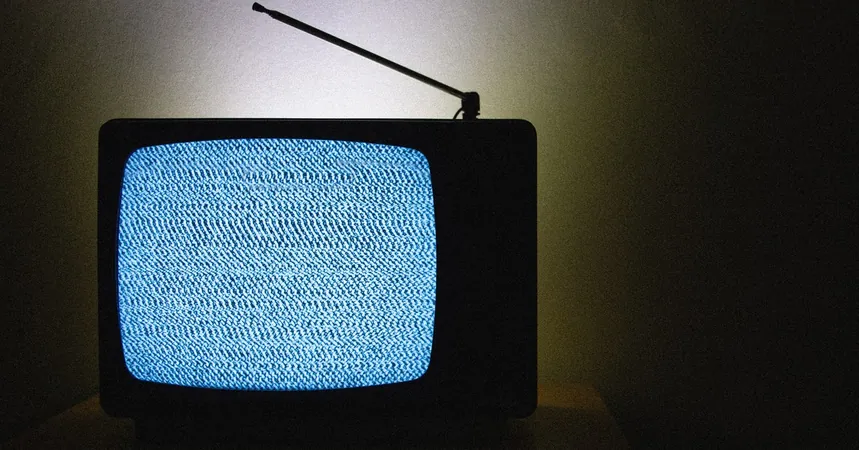
The Troubling Fate of Broadcast TV: Is Trump Adding Fuel to the Fire?
2025-01-21
Author: Jia
Overview of the Crisis in Broadcast TV
Broadcast television is grappling with a significant crisis as its viewership continues to dwindle. Over the last twenty years, audiences have increasingly shifted their viewing habits to online platforms, resulting in a sharp decline in traditional TV viewership. With the rise of streaming services, major broadcasts are losing their top talent, leading to a continuous drop in advertising revenue. Adding to the turmoil, former President Donald Trump and his preferred choice for Federal Communications Commission (FCC) chair, Brendan Carr, are reportedly threatening to revoke broadcast licenses from networks that air content unfavorable to their administration.
The Value of Broadcast TV
This predicament raises concerns about the future of one of the remaining free sources of news and entertainment. While broadcast TV does require a television and a digital tuner, it does not necessitate a monthly subscription like streaming services, and crucially, it does not gather extensive data for advertising purposes. It's a passive viewing experience that is rapidly losing its audience.
Trends in Viewership
Industry experts, like Rose Oberman from S&P Global Ratings, acknowledge that while the decline of broadcast television is anticipated, it will be a slow and gradual erosion, akin to the fate of radio over recent decades. The shift from cable subscriptions to streaming options marks a clear trend as viewers opt for more customizable content.
The Impact of Sports Broadcasting
Sports broadcasting has been a significant revenue source for TV networks, but changes are underway. The Super Bowl 2024 marked a pivotal moment when it streamed on Paramount Plus, garnering millions of new subscribers despite a less-than-perfect viewing experience. The Olympics followed suit, capitalizing on viewer preferences for on-demand content. Furthermore, Netflix's successful streaming of two NFL games—featuring a star-studded halftime show—set a new record for viewership, showcasing the streaming platforms' growing dominance.
Challenges for Traditional Networks
These developments are poised to challenge existing contracts for broadcasting live sports, with major leagues reconsidering their alliances with traditional networks. As streaming giants like Netflix and Amazon actively pursue expensive rights, such as the $1 billion per year Amazon committed to for NFL Thursday Night Football, traditional broadcasters are feeling the pinch.
Network Television Cutbacks
The impact of this shift is not limited to sports. Network television is already undergoing severe cutbacks. For instance, Hoda Kotb recently exited the Today show after 17 years, reportedly due to NBC's desire to reduce costs associated with high-profile hosts. Similarly, reductions in the number of episodes for popular late-night shows signal a broader trend of financial austerity affecting the entire industry.
Political Influences on Broadcast
Amid this transformation, Trump’s threats to broadcast networks seem rooted in a broader political strategy targeting national news outlets rather than local stations specifically. Experts suggest that while tensions may exist, they do not appear to affect the industry significantly, as local stations continue to maintain viewership and profitability.
Future Opportunities
Broadcast companies are also looking to capitalize on potential regulatory changes that could allow for greater consolidation among local stations. Industry leaders like Perry Sook from Nexstar express optimism about the evolution of journalism towards a fact-based approach, distancing themselves from what they perceive as overly activist reporting.
The Role of Local Stations
Interestingly, while some local stations align with conservative viewpoints, they continue to be vital for political advertising—an area where digital platforms struggle to deliver the same results. In fact, broadcast TV experienced a 9% surge in ad revenue in 2024, driven by a significant influx of political advertising during election cycles.
Looking Ahead
However, following the elections, this financial boost is expected to decline, compounding the challenges facing broadcast TV. Even if the current administration fails to act on its threats, the landscape for traditional television remains precarious. The once-dominant medium finds itself at a crossroads, vulnerable and at risk of fading into obscurity.
Conclusion
In conclusion, the situation for broadcast television is increasingly grim. With Trump’s political maneuvering adding uncertainty and the migration of audiences to streaming platforms, one can only wonder how long this traditional media staple can survive in an ever-evolving entertainment ecosystem. The question remains: is this the beginning of the end for broadcast TV? A media revolution may be underway, and it could leave traditional networks obsolete if significant changes are not made.



 Brasil (PT)
Brasil (PT)
 Canada (EN)
Canada (EN)
 Chile (ES)
Chile (ES)
 Česko (CS)
Česko (CS)
 대한민국 (KO)
대한민국 (KO)
 España (ES)
España (ES)
 France (FR)
France (FR)
 Hong Kong (EN)
Hong Kong (EN)
 Italia (IT)
Italia (IT)
 日本 (JA)
日本 (JA)
 Magyarország (HU)
Magyarország (HU)
 Norge (NO)
Norge (NO)
 Polska (PL)
Polska (PL)
 Schweiz (DE)
Schweiz (DE)
 Singapore (EN)
Singapore (EN)
 Sverige (SV)
Sverige (SV)
 Suomi (FI)
Suomi (FI)
 Türkiye (TR)
Türkiye (TR)
 الإمارات العربية المتحدة (AR)
الإمارات العربية المتحدة (AR)